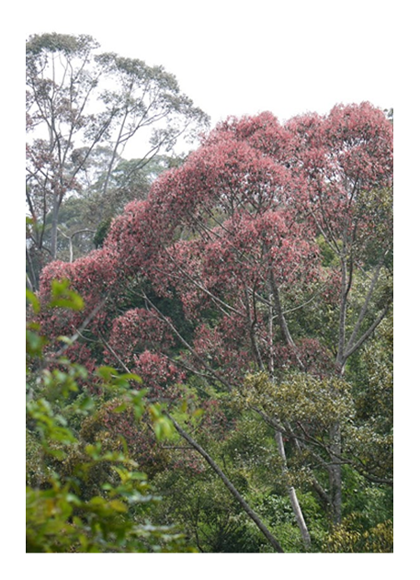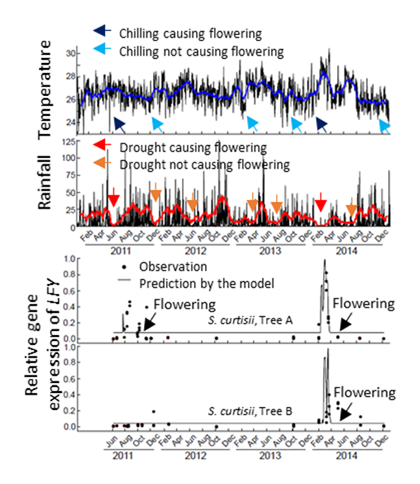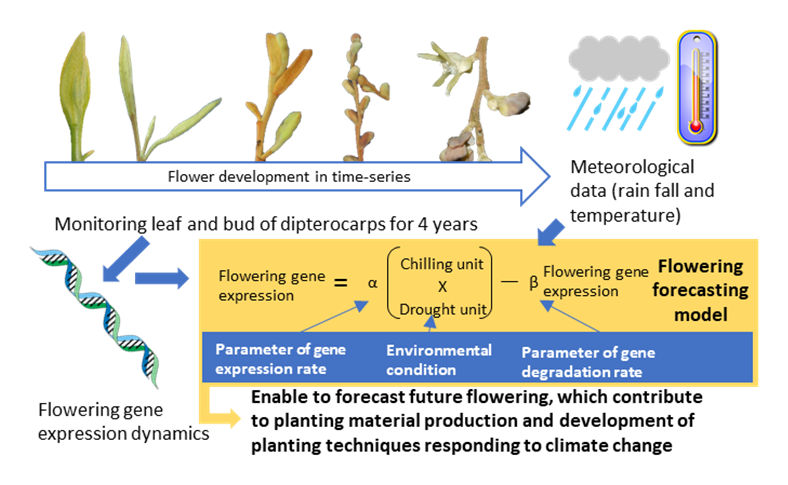Forecasting mass synchronized flowering in Southeast Asian tropical forest by analyzing the dynamics of flowering gene expression
Description
In Southeast Asian tropical forests, irregular and prolonged synchronized flowering is observed not only on dipterocarp species (the major canopy species in these forests) but also on various tree species belonging to different taxa. Synchronized flowering is basically triggered by environmental factors such as low temperature and drought. However, the mechanisms and the relationship between these factors have not been well studied, making synchronized flowering difficult to forecast. Dipterocarp trees, generally known as Lauan and mainly used for timber and plywood, constitute about 80% of canopy species in Southeast Asian tropical forests. Difficulties on its vegetative propagation have forced us to make planting materials throughout seed collection during fruiting season. However, unpredictable flowering and seeding of dipterocarps restrict the planned production of planting materials. Furthermore, climate change could alter environmental factors, modifying the synchronized flowering pattern in the region and possibly affecting not only the regeneration of tropical tree species but also forest ecosystems. Therefore, we monitored the flowering phenology and expression of flowering genes of two dipterocarp species (Shorea curtisii and S. leprosula) for about four years, and developed a flowering forecasting model from climate data.
High homology of the RNA sequences with the Arabidopsis gene database indicates that the FT- and LFY-like genes of S. curtisii also regulate flowering of the species. These genes were expressed in leaf and bud tissues at least one month before synchronized flowering (Fig. 2). We then developed a flowering forecasting model to estimate the parameters of gene expression and degradation, and to determine the environmental factors that cause flowering. The estimation showed that both low temperature and drought were necessary for flowering. The environmental thresholds for daily temperature and precipitation (drought) ranged from 25.5 to 25.7 and from 156 to 182 mm over 9-11 weeks, respectively (Fig. 2), suggesting that lower temperatures and dry conditions (i.e., the values are below threshold over 9-11 weeks) express the flowering genes. Flowering is initiated after more than one month. The estimation can contribute to planned seed collection because it enables stakeholders to prepare seed collections at least 9-11 weeks before flowering.
Our model and estimated parameters can also be utilized for forecasting flowering under climate change conditions. We can input environmental data (temperature and precipitation) and incorporate climate change scenarios into our model to predict gene expression behavior, thus contributing to the discussion on the effects of climate change on forest regeneration and the ecosystem. It should be noted, however, that the estimated parameters and environmental conditions were based only on two flowering events over the four-year observation period, and that more monitoring data are required to develop a more precise model.
Figure, table
-
Fig. 1. Seeding of S. curtisii (at Semangkok Forest Reserve in July 2014)
-
Fig. 2. Daily temperature and rainfall (top), and expression of flowering gene during observation period (bottom)
-
Fig. 3. Method for developing the flowering forecasting model
- Affiliation
-
Japan International Research Center for Agricultural Sciences Forestry Division
- Program name
- Research Project
-
Elucidating the mechanism of masting by integrated analysis of flowering gene expression and soil / plant nutrient conditions
- Term of research
-
FY2017(2014~2016)
- Responsible researcher
-
Tani Naoki ( Forestry Division )
KAKEN Researcher No.: 90343798Satake Akiko ( Kyushu University )
KAKEN Researcher No.: 70506237Ichie Tomoaiki ( Kochi University )
KAKEN Researcher No.: 80403872Numata Shinya ( Tokyo Metropolitan University )
KAKEN Researcher No.: 20391138Yeoh Suat Hui ( University of Malaya )
Lee Soon Leong ( Forest Research Institute Malaysia )
Basherudin Norlia ( Forest Research Institute Malaysia )
Muhammad Norwati ( Forest Research Institute Malaysia )
- ほか
- Japanese PDF
-
A4 323.62 KB
A3 319.87 KB
- English PDF
-
A4 287.08 KB
A3 226.83 KB
- Poster PDF
-
2017_C03_poster.pdf542.53 KB



